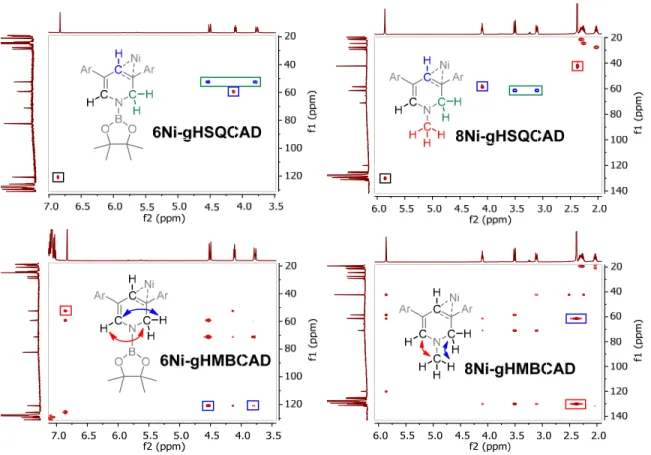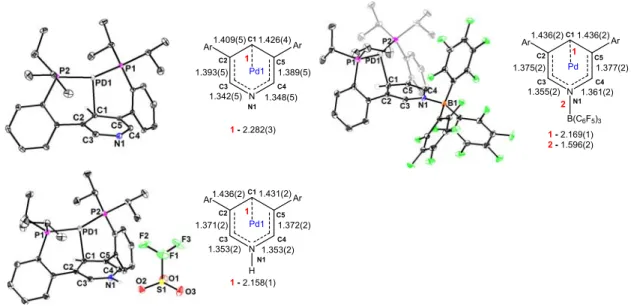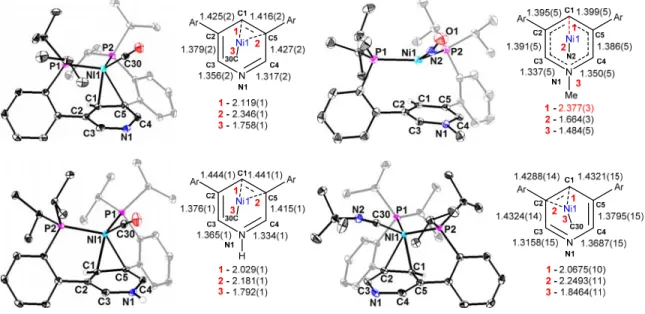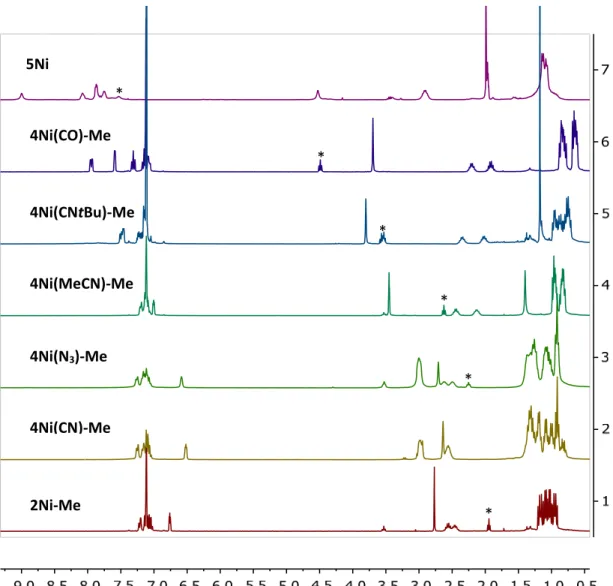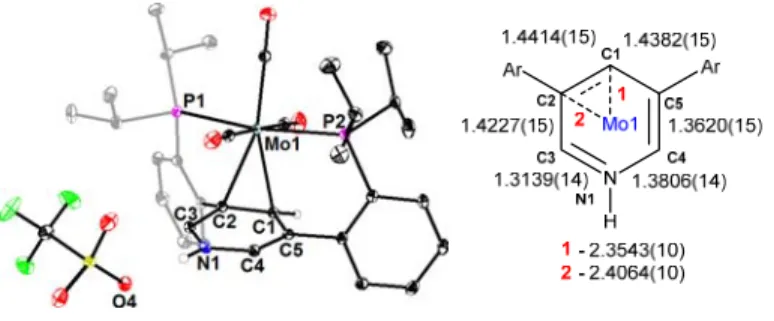This shift is probably due to an electronic effect caused by the Lewis acid binding. Consequently, the strong interactions of the metal-pyridine π-system result in an even larger upshift of H-C1 compared to 2Ni. NMR evidence indicates selective derivatization of the pyridine nitrogen by the electrophile rather than a nickel-based reaction such as oxidative addition.
This is likely due to the cationic nature of the electrophile attached to the pyridine nitrogen (B(C6F5)3 vs Me+), resulting in a significantly more electron-deficient central pyridine. For 2Ni-BCy2OTf, the cyclohexyl substituents complicate the aliphatic region of the 1H NMR spectrum. This part of the structure of 2Ni demonstrates the potential for flexible metal-pyridine π-system interactions that vary with ligand coordination.
The reduction of the Ni–C30 distance to 1.930(2) Å indicates a stronger interaction between the metal and the π-system compared to 2Ni. These distances are consistent with partial isolation of C30 from the pyridine π-system, resulting in delocalization over the remaining 5 atoms. The above structural parameters demonstrate the plasticity of the pyridine π-system and its potential for rearrangement as a function of Lewis acid functionalization of the pyridine nitrogen.
Due to the increased size of the metal center, the coordination angle of diphosphine is larger with palladium.
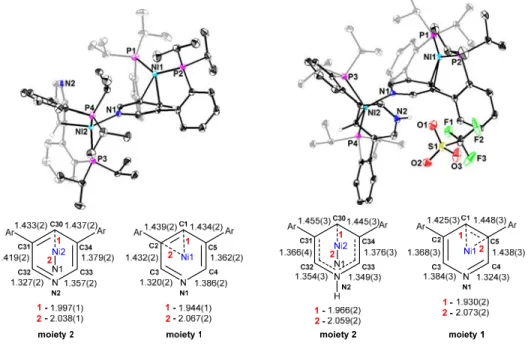
Synthesis of small molecule-coordinated Ni complexes
The shortest Ni-pyridine interactions for 4Ni(CO) and 4Ni(CO)-H, 2.119(1) and 2.029(1) Å, respectively, are elongated relative to part 2 of 2Ni (1.997(1) Å) and 3Ni (1.966(2) Å), consistent with the CO ligand being generally more acidic than the N-bonded pyridine, leaving the metal center less prone to back-bonding with the pyridine π-system. The proton chemical shift of C1 (7.55 ppm) and C3/C4 (9.01 ppm) occurs in the aromatic region, suggesting weaker interactions of the metal-pyridine π-system than either of the CO complexes. The sum of the P–Ni–P and P–Ni–N angles is 350.78° and approaches the theoretical value for ideal trigonal planar coordination.
The Ni-N2-O1 angle is consistent with the linear nitrosyl moieties of the literature related to Ni.16 These data indicate that the pyridinium ring cannot compete with the nitrosonium ligand for nickel coordination. Since carbon monoxide is expected to be a better π-acid than tert-butyl isocyanide, 4Ni(CO) is expected to exhibit a weaker π-Ni-pyridine system interaction compared to 4Ni(CNtBu) since the ligand coordinated competes better for electron density with the heterocycle. In general, the effect of a change in the p-acidity of the donor ligand shifts the C1-H chemical shift by approximately half that resulting from bonding B(C6F5)3 to the pyridine nitrogen (H-C1 δ(ppm): 4Ni( CO)-B(C6F5)3 4.61).
Both complexes show η2 coordination modes with a shorter average Ni–C distance (4Ni(CO) 2.23 Å, 4Ni(CNtBu) 2.16 Å) seen for 4Ni(CNtBu) consistent with a stronger Ni-pyridine π-system interaction . In a similar way, NMR comparisons over the series of 4Ni(L)-Me (L = CN-, N3-, MeCN, CNtBu, CO) and 5Ni allow for an assessment of the strength of the Ni-pyridine π -system interacts with a wide variety of small molecules while keeping the pyridine substitution constant (Figure 8). These results confirm the interaction between the electronics of the small molecule and the N-functionalized pyridine by looking at the chemical shift of the H-C1 proton.
The metallopyridine π-system interaction can also be modulated with the π-acidity of coordinated ligand. With the influence of the aromatic ligand on the metal center demonstrated, the activation of the heterocycle by the metal after reactivity was also investigated. With the aromaticity of pyridine partially disrupted by metal coordination, reactivity at the N=C moiety was targeted.
Furthermore, asymmetric signals for the central pyridine protons are observed, consistent with the hydroboration or hydrosilylation of a C-N bond of the pyridine rather than a 1,4 selective reaction or a formal oxidative addition at the nickel center. The assignments for the remaining central pyridine protons are completed using a combination of gHSQCAD and gHMBCAD experiments, which locate the C1 and the remaining ortho-pyridine protons at 4.11 and 6.83 ppm and 4.13 and 6.40 ppm for 6Ni and 7Ni, respectively confirmed (Figure respectively) 9). Complete assignments of the central pyridine carbons were also made (See Experimental Section), supporting the 1,2 substitution pattern assignment.
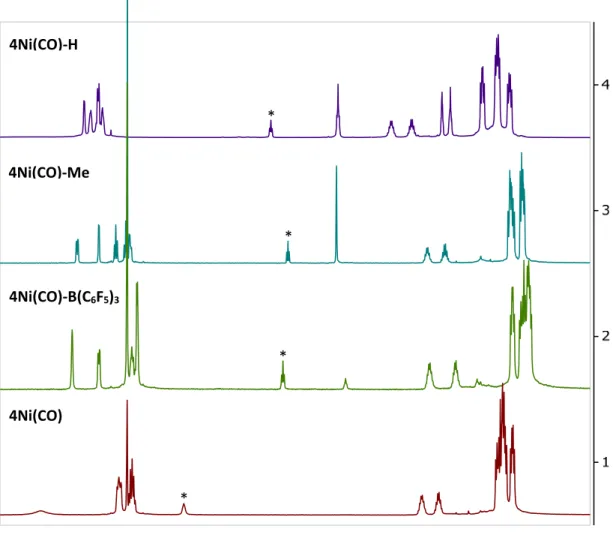
Reactivity at pyridine beyond Lewis acid binding: synthesis of dearomatized pyridine complexes
Access to these reduced species is, however, sensitive to the steric and electronic properties of the reagents. Attachment of groups such as boranes, H+ or Me+ results in stronger interactions of the metal center with the pyridine π-. Dearomatization of the pyridine ring was observed in stoichiometric reactions between phenylsilane or pinacol borane and 2Ni, with the heteroatom bonding to nitrogen and the orthogen to N.
This ligand-based reactivity is likely a consequence of the activation of the pyridine ring by the metal center through disruption of aromaticity. At this point, GC-MS analysis of an aliquot of the organic fraction indicated complete conversion to the desired product. The volatiles in the filtrate were removed under reduced pressure to give the product as a dark brown lumpy solid.
The solution was then filtered through a Celite pad and the volatiles from the resulting filtrate were removed under reduced pressure, yielding clean product as an orange solid without further purification. The volatiles from the filtrate were removed under reduced pressure to yield the product as a dark brown solid. approx. 5 ml) and transferred to a 20 ml scintillation vial equipped with a magnetic stir bar. The volatiles from the filtrate were then removed under reduced pressure to yield a pinkish-purple solid.
The material can be recrystallized from tetrahydrofuran:hexanes to give the desired product as brown crystals sufficient to identify the compound in the solid state. Lyophilization of the solvent gave the desired pure product as a brown powder without further purification. Lyophilization of the solvent gave the desired pure product as a brown powder without further purification.
The solution was stirred for 3 hours, during which time a lightening of the solution was observed, consistent with the formation of 4Ni(CO). Removal of the volatiles under reduced pressure gave the desired pure product as a red-brown powder without further purification. 2 h, during which time the [Me3O][BF4] dissolved and a significant darkening of the solution to a color similar to that of 2Ni-Me was observed.
The product was eluted from the Celite pad with acetonitrile, and volatiles from the blue filtrate were removed under reduced pressure. 186 was then added via Hamilton syringe which resulted in an immediate relief of the dissolution and precipitation of salts. The volatiles from the filtrate were removed under reduced pressure to yield the desired product without further purification.
31P NMR data on C6D6 show clean conversion to a new species, however, removal of tetrabutylammonium triflate by solvent washing of recrystallization proved difficult.
